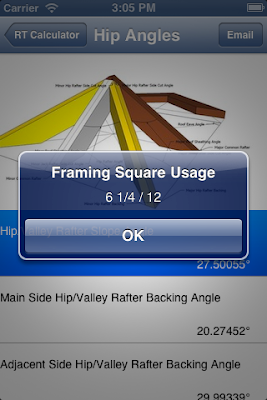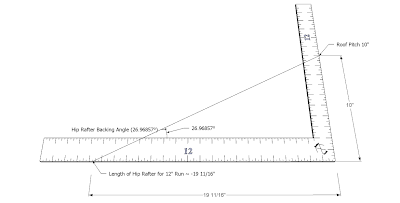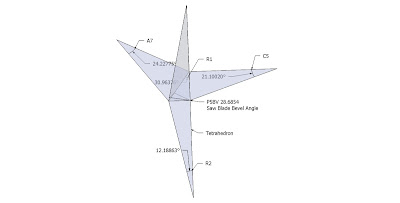Using the default settings in Rafter Tools+ for iPhone
90° Eave angle
8:12 main roof pitch
10:12 adjacent roof pitch
3 ½” for the width of the hip rafter
Press the calculate
button
Then Scroll down the page, the calculated results should
look like the following:
Main Slope Angle
33.69007
Adjacent Slope Angle
39.80557
Main Plan Angle
51.34019
Adjacent Plan Angle
38.65981
Hip Rafter Layout
@ Foot of Hip Rafter
Hip Rafter Layout
@ Foot of Hip Rafter
Hip Rafter Slope Angle
27.50055°
Main HR Backing Angle
20.27452°
Adjacent HR Backing Angle
29.99339°
Hip Rafter Width
3 1/2''in
Hip Rafter Backing Depth Dimension
13/16''in
Hip Rafter Plumb Line Shift Dimension
1 11/16''in
Main HR Shift Dimension Perpendicular to HR Run Line
2 1/8''in
Adjacent HR Shift Dimension Perpendicular to HR Run Line
1 3/8''in
Main HR Saw Blade Bevel Angle @ foot of HR
38.65981°
Adjacent HR Saw Blade Bevel Angle @ foot of HR
51.34019°
Hip Rafter Layout
@ Peak of Hip Rafter
Hip Rafter Layout
@ Peak of Hip Rafter
Main HR Bevel Angle
35.35971°
Adjacent HR Bevel Angle
47.95238°
Main HR Saw Blade Bevel Angle @ peak of HR
51.34019°
Adjacent HR Saw Blade Bevel Angle @ peak of HR
38.65981°
Main HR Plumb Line Shift Dimension
2 11/16''in
Adjacent HR Plumb Line Shift Dimension
1 1/16''in
Hip Rafter Square Tail Fascia Layout
Hexenschnitt The Witches Cut
Hip Rafter Square Tail Fascia Layout
Hexenschnitt The Witches Cut
Main HR Miter Angle
77.01151°
Adjacent HR Miter Angle
64.35702°
90° - Main HR Miter Angle
12.98849°
90° - Adjacent HR Miter Angle
25.64298°
Main HR Back Bevel Angle
58.01937°
Adjacent HR Back Bevel Angle
50.25040°
Main HR Saw Blade Bevel Angle
31.31734°
Adjacent HR Saw Blade Bevel Angle
36.86131°
Main HR Miter Line Shift Dimension @ tail of HR
1 5/16''in
Adjacent HR Miter Line Shift Dimension @ tail of HR
1 ''in
Next press the Lengths button
Enter
Main Rafter Run = 22
Ridge Width = 3.5
Material Depth = 3.5
SeatCut Length = 1.5
Main Overhang Run = 6
Make sure the Unequal
button is selected, then press the calculate button, it will calculate the roof
rafter lengths for an unequal overhang roof.
Then Scroll down the page, the calculated results should
look like the following:
Main Rafter Run
22 ''in
Main Rafter TL
26 7/16''in
Main Rafter Length to Ridge
24 5/16''in
Main Rafter OverHang Run
6 ''in
Main Rafter OverHang Rafter Length
7 3/16''in
Main Rafter Seatcut Length
1 1/2''in
Main Rafter HAP
3 3/16''in
Main Rafter Plumb Height
4 3/16''in
Plate Height Difference
0
Hip Rafter Offset From Corner
0
Adjacent Rafter Run
17 5/8''in
Adjacent King Rafter TL
22 15/16''in
Adjacent King Rafter Length to Ridge
21 1/16''in
Adjacent Rafter OverHang Run
4 13/16''in
Adjacent Rafter OverHang Rafter Length
6 1/4''in
Adjacent Rafter Seatcut Length
1 5/8''in
Adjacent Rafter HAP
3 3/16''in
Adjacent Rafter Plumb Height
4 9/16''in
Hip Rafter Run
28 3/16''in
Hip Rafter TL
31 3/4''in
Hip Rafter Length to Ridge
29 1/4''in
Hip Rafter Length to Long Point
31 3/16''in
Hip Rafter OverHang Run
7 11/16''in
Hip Rafter OverHang Rafter Length
8 11/16''in
Ridge Height
16 11/16''in
We’ll layout the hip rafter using the Hip Rafter Length to
Ridge, 29 1/4''in, and the Hip Rafter OverHang Rafter Length, 8 11/16''in.
Mark 3 perpendicular lines on the top edge of the hip rafter using
these dimensions.
 Next click on the Hip
Angles button and then click on the Hip/Valley Rafter Slope Angle text. It
will display the Framing Square Usage for the Slope Angle of the Hip Rafter,
27.50055°, 6 ¼ / 12. We’ll use the 12” as the rotation point on the framing
square and move the other end of the framing square to the edge of the hip
rafter material using the 6 ¼” rotation dimension.
Next click on the Hip
Angles button and then click on the Hip/Valley Rafter Slope Angle text. It
will display the Framing Square Usage for the Slope Angle of the Hip Rafter,
27.50055°, 6 ¼ / 12. We’ll use the 12” as the rotation point on the framing
square and move the other end of the framing square to the edge of the hip
rafter material using the 6 ¼” rotation dimension.
Draw the Hip Rafter Level Plane Line
Draw the hip rafter backing depth line on both sides of the hip rafter using the Hip Rafter Backing Depth Dimension of 13/16''in.
Draw a hip rafter plumb line using the Hip Rafter Plumb Line Shift Dimension of 1 11/16''in.
The Hip Rafter Plumb Line Shift Line & the Hip Rafter Level Plane Line must intersect at the hip rafter backing depth line. These 3 lines must intersect at the Roof Plane Alignment Point.
Draw a line on the top edge of the hip rafter using Main HR Shift Dimension Perpendicular to HR Run Line
2 1/8''in
Draw the Hip Rafter Back Bevel Lines at the hip rafter seat. It will result in the Main HR Bevel Angle of 47.95238° and the Adjacent HR Bevel Angle 35.35971° .
Draw the hip rafter seat cut line at the dimension for the Main Rafter HAP of 3 3/16''in.
At the peak of the hip rafter draw the Main HR Plumb Line Shift Dimension @ 2 11/16''in
and the
Adjacent HR Plumb Line Shift Dimension @1 1/16''in
On the main screen of Rafter tool+ for iPhone the miter angles for square tail fascia are displayed as
Main HR Miter Angle
77.01151°
Adjacent HR Miter Angle
64.35702°
90° - Main HR Miter Angle
12.98849°
90° - Adjacent HR Miter Angle
25.64298°
An easy way to use these miter angles is to click on the Hip Angles button and then click on the Main Side Hip Rafter Purlin Housing Angle, Square Tail Fascia Hip Rafter, or Witches Cut, Miter Angle text. It will display the Framing Square Usage for the Square Tail Fascia Hip Rafter Miter Angle of , 12.98849°, 2 3/4 / 12. We’ll use the 12” as the rotation point on the framing square and move the other end of the framing square to the edge of the hip rafter material using the 2 3/4” rotation dimension.
An easy way to use these miter angles is to click on the Hip Angles button and then click on the Main Side Hip Rafter Purlin Housing Angle, Square Tail Fascia Hip Rafter, or Witches Cut, Miter Angle text. It will display the Framing Square Usage for the Square Tail Fascia Hip Rafter Miter Angle of , 12.98849°, 2 3/4 / 12. We’ll use the 12” as the rotation point on the framing square and move the other end of the framing square to the edge of the hip rafter material using the 2 3/4” rotation dimension.
Layout the Square Tail Fascia miter angle as shown in this next drawing using 2 3/4 & 12 on the framing square.
Repeat the process on the adjacent pitch side of the hip rafter using 5 3/4 & 12 on the framing square, for a miter angle of 25.64298°.
Use the Main HR Miter Line Shift Dimension @ tail of HR 1 5/16''in to draw a line parallel with the HR Miter Line. Repeat the process on the adjacent pitch side of the hip rafter using, Adjacent HR Miter Line Shift Dimension @ tail of HR 1 ''in.
Draw the Square Tail Fascia Back Bevel Angle Lines on the top & bottom edges of the hip rafter.
Draw the Square Tail Fascia Back Bevel Angle Lines on the top & bottom edges of the hip rafter.
The Hip Rafter Square Tail Fascia Miter Line Shift Line & the Hip Rafter Level Plane Line must also intersect at the hip rafter backing depth line. These 3 lines intersect at the Roof Plane Alignment Point.
Set your saw to the Main HR Saw Blade Bevel Angle 31.31734° and Adjacent HR Saw Blade Bevel Angle 36.86131° and cut along the miter lines of the hip rafter square tail.






















































